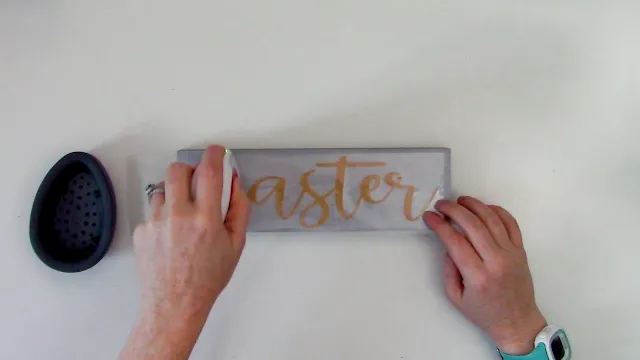Did you know that you can press HTV onto raw, stained, or painted wood? If the piece of wood is too thick though - a heat press won't work!
Why Use HTV on Wood?
HTV on wood definitely has some advantages over adhesive vinyl and stencils. Some people find working with HTV preferable to adhesive vinyl - weeding can be easier with HTV and you don't have to mess around with transfer tape. And you don't have to wait for paint to dry like you would with a stencil.
Also, the cut and weeded HTV on the carrier sheet is repositionable, so you can shift the design around on your project to get it perfectly lined up. You certainly can't do that with adhesive vinyl!
If the wood is thin you can use a heat press, but if the wood is too thick a heat press, especially a clamshell, won't close and you won't get even pressure.
That's where using a Cricut Easypress for HTV on wood is key!
Tips for Pressing HTV onto Wood with an Iron or EasyPress
Start by prepping the wood. The more well sanded the wood - the better. Then paint, stain, or leave the wood raw.
Make sure the paint or stain is completely dry before pressing HTV onto it.
It's a good idea to do a test press of some HTV onto a piece of scrap wood before diving right into your project. The time, temperature, and pressure of the mini press on the HTV can vary, and you want to test how the raw wood, paint, or stain reacts to heat.
Use the minimum amount of heat, time, and pressure required to get the HTV to stick to the wood.
Since the wooden project isn't going to be washed and worn (like a t-shirt, for example), you do not need to press the HTV for the recommended settings. In fact, doing so could actually melt the HTV and/or distort the design.
Peel the carrier sheet warm.
Begin by removing the edge of the carrier sheet, slowly, as you lift it up to check that the HTV has indeed adhered to the wood.
If you notice part of the HTV coming up with the carrier sheet, just press the carrier sheet back down and re-press over that area with the EasyPress.
Can You Layer HTV on Wood?
Yes! Just remember, if you're layering HTV it's incredibly important to not to place the mini press or iron directly onto the HTV - it will melt!
If the first layer of HTV is exposed when you add the second layer, cover everything with a piece of parchment paper or reuse an HTV carrier sheet from a previous project before pressing.
Note: This post may contain affiliate links. By clicking on them and purchasing products through my links, I receive a small commission. That's what helps fund Silhouette School so I can keep buying new Silhouette-related products to show you how to get the most out of your machine!
Get Silhouette School lessons delivered to your email inbox! Select Once Daily or Weekly.
















.png)




No comments
Thanks for leaving a comment! We get several hundred comments a day. While we appreciate every single one of them it's nearly impossible to respond back to all of them, all the time. So... if you could help me by treating these comments like a forum where readers help readers.
In addition, don't forget to look for specific answers by using the Search Box on the blog. If you're still not having any luck, feel free to email me with your question.